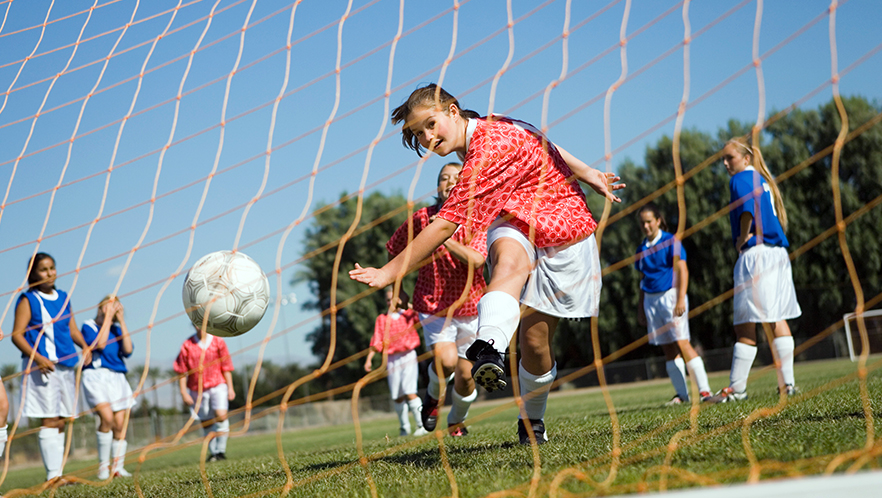The summer sports season is kicking into high gear, and many proud parents will pull out their camera gear in hopes of capturing their child’s big hit or game-winning goal. Unfortunately, many will just end up with a bunch of blurry images.
So we turned to veteran sports photographer Nick Didlick for some advice on shooting youth sports. The Vancouver, B.C.-based pro has covered 10 Olympics, five Super Bowls, seven Stanley Cup Finals and various other high-profile sporting events over the past 40 years. (He also has helped train the photography experts at the Camera Experience Shops inside about 120 Best Buy stores.)
Here are a few of Nick’s top tips for getting great action shots, whether you’re at your kid’s game or covering a world championship.
Know your sport
First off, it’s important to know the sport you’re shooting. Knowing how the action unfolds will help you get in place for the best shots.
Nick recalls a time early in his career when he was assigned to cover a rodeo but had no idea what to expect. So he asked an old cowboy for tips. The cowboy gave specific advice about how the broncos would buck, and Nick got such great photos that he became the rodeo specialist at his newspaper.
“If you don’t know anything about the event you are photographing, you’re not going to catch very good pictures,” he said. “You don’t have to understand it in detail, but you need to know the basics so you can put yourself in a position to catch great pictures.”
Know your players
It’s also important to know what position your child plays so you can get yourself in the right position to capture him or her in action.
For example, if your daughter is the top scorer on the soccer team, you’ll want to position yourself near the net on the offensive side of the field. Or if your son is a left-handed batter, you’ll want to shoot from the third baseline so you can see his face.
Make a plan
You can’t just wander around the field or sit in the stands at little Jimmy’s game and hope for a good photo. Identify different moments that you want to capture and make a shot list—and remember, they don’t all have to be action shots.
Other possibilities include your child:
- Talking with the coach
- Going through warmups
- Being introduced to the crowd or lining up for the national anthem
The goal is to be more thoughtful about the shots you want to capture. You’ll probably find yourself shooting less but coming away with better shots.
“If you think through the flow of the sport and do a bit of planning upfront, you will be able to put yourself in position to come away with seven to 10 great pictures,” Nick said.
Choose your equipment wisely
It’s important to choose the right equipment for the event you want to capture. If you can do it all with a camera, one lens, a spare battery and a spare memory card, that makes you really mobile and able to move around as needed to capture the best images.
“You don’t need every piece of gear you own,” said Nick, who shoots with a Sony Alpha a9.
Choosing the best lens will depend on the sport, but he recommends a 70-300mm zoom lens for outdoor sports. For indoor sports, he uses a lens with a really wide aperture, such as a 50mm f/1.4 or f/1.8, that’s good for artificial or low light.
Get your settings right
There is nothing worse than getting to the field and fumbling with settings during the game.
For sports photography, Nick suggests using Shutter Priority mode and a shutter speed of 1/500 of a second or faster. Sometimes he’ll use 1/1000 or 1/2,000 of a second if there’s enough light.
“It’s all about the shutter speed,” he said.
Time your shot
Getting the right shot is all about timing. Click a second too late and you’ll miss it. Start clicking a few seconds too early and the camera might start to buffer and slow down before the big moment.
“Stay calm and just think about that decisive moment you are trying to capture,” Nick said.
It also helps to have a speedy memory card, ideally around 95 MB per second. That means the memory card will be able to process 95 MB of photos in one second, allowing you to shoot as much as possible during key moments in the action.
Use your smartphone
If you don’t have a DSLR camera, your smartphone is another great option. However, you’ll be limited by your lens and the lighting. That makes it tough to get great action shots, even when using your digital zoom.
“You don’t have as many options as you would with a 70-300mm lens,” Nick said. “You may have to get closer for some of the images, and you may have to give up on some of the pictures that you hoped to get because you don’t have a device that is capable of capturing that.”
But you’ll still be able to get some great shots. For example, Nick suggests sticking next to the coach so you can capture a special moment when your son or daughter comes back to the bench for a drink of water.
“One of the beautiful things about smartphones is not so much their still capability, but their video capability,” he said. “I would plan to get a series of little video clips and make a video vignette of that game, for instance.”
Want more ideas for how to get the perfect action shot? Check out the photography tips and tricks on BestBuy.com or sign up to attend the Vacation and Action Photography workshop at select Best Buy stores on June 3.


